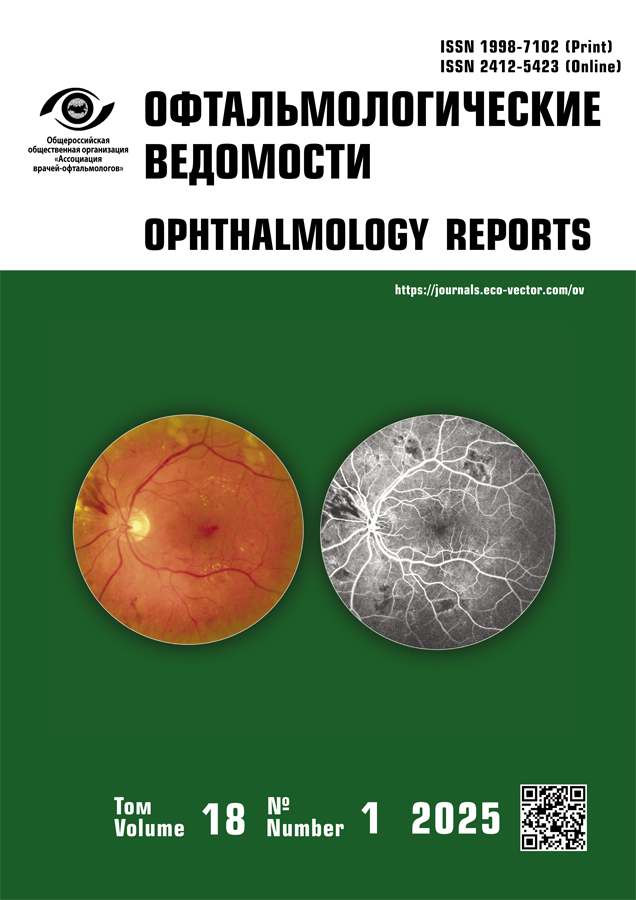Biomechanical properties of lacrimal drainage pathways in dacryostenosis
- Authors: Atkova E.L.1, Yartsev V.D.1, Novikov I.A.1, Ekaterinchev M.A.1, Mazurova Y.V.1
-
Affiliations:
- M.M. Krasnov Research Institute of Eye Diseases
- Issue: Vol 18, No 1 (2025)
- Pages: 17-24
- Section: Original study articles
- Submitted: 13.03.2024
- Accepted: 02.11.2024
- Published: 04.04.2025
- URL: https://journals.eco-vector.com/ov/article/view/629041
- DOI: https://doi.org/10.17816/OV629041
- ID: 629041
Cite item
Abstract
BACKGROUND: In the literature, there is a deficit of data regarding clinical and morphological correlations in characterizing lacrimal drainage pathways. However, changes in the biomechanical properties of the lacrimal drainage pathways may influence the clinical picture of dacryostenosis, and may also have a predictive value in the context of prognosis of surgical procedures.
AIM: The aim of this study is to study of changes in the viscoplastic properties of the lacrimal sac wall in dacryostenosis
MATERIALS AND METHODS: The study included 38 patients with dacryostenosis. All patients underwent a biometric examination of lacrimal drainage pathways to determine the average area of their section. All observations were divided into cases with stenotic changes (at an average section area of the lacrimal drainage pathways less than 0.18 mm2 — 26 observations) and with ectatic changes (at an average section area of lacrimal drainage pathways equal to or more than 0.18 mm2 — 12 observations). The biomechanical properties of lacrimal sac wall samples obtained during dacryocystorinostomy were analyzed. The peak value of the viscosity of the lacrimal sac wall and the integral viscosity of the lacrimal sac wall (AUC) were determined.
RESULTS: In patients with stenotic changes, a correlation was determined between the duration of lacrimation and the average section area of lacrimal drainage pathways (r = –0.537, p = 0.018), in patients with ectatic changes, a correlation was determined between the average section area of lacrimal drainage pathways and the peak value of the viscosity of the lacrimal sac wall (r = 0.662, p = 0.019). No correlations of biometric parameters with the integral viscosity of the lacrimal sac wall (AUC) were found.
CONCLUSIONS: At stenotic changes in lacrimal drainage pathways, the average area of their section depends on the duration of lacrimation; this dependence is absent when a critical level of ectasia is reached. With an increase in the average cut area of lacrimal drainage pathways, the value of the peak viscosity of the lacrimal sac wall increases.
Full Text
About the authors
Eugenia L. Atkova
M.M. Krasnov Research Institute of Eye Diseases
Email: evg.atkova@mail.ru
ORCID iD: 0000-0001-9875-6217
SPIN-code: 1186-4060
MD, Dr. Sci. (Мedicine)
Russian Federation, 11A Rossolimo st., Moscow, 119021Vasily D. Yartsev
M.M. Krasnov Research Institute of Eye Diseases
Email: v.yartsev@niigb.ru
ORCID iD: 0000-0003-2990-8111
SPIN-code: 4151-4946
MD
Russian Federation, 11A Rossolimo st., Moscow, 119021Ivan A. Novikov
M.M. Krasnov Research Institute of Eye Diseases
Email: ivan.a.novikov@gmail.com
ORCID iD: 0000-0003-4898-4662
SPIN-code: 3560-1550
MD
Russian Federation, 11A Rossolimo st., Moscow, 119021Maksim A. Ekaterinchev
M.M. Krasnov Research Institute of Eye Diseases
Author for correspondence.
Email: maximus-ek@mail.ru
ORCID iD: 0000-0001-8268-2540
SPIN-code: 9251-2884
MD
Russian Federation, 11A Rossolimo st., Moscow, 119021Yulia V. Mazurova
M.M. Krasnov Research Institute of Eye Diseases
Email: julia.mazurova@bk.ru
ORCID iD: 0000-0003-2503-842X
SPIN-code: 2093-0888
MD, Cand. Sci. (Medicine)
Russian Federation, 11A Rossolimo st., Moscow, 119021References
- Demyashkin GA, Yartsev VD, Atkova EL, et al. Morphological characteristics of the lacrimal apparatus in its obstruction of various genesis. Indian J Otolaryngol Head Neck Surg. 2023;75(S1):951–956. doi: 10.1007/s12070-023-03493-y
- Ali MJ, Paulsen F. Etiopathogenesis of primary acquired nasolacrimal duct obstruction: what we know and what we need to know. Ophthalmic Plast Reconstr Surg. 2019;35(5):426–433. doi: 10.1097/IOP.0000000000001310
- Kashkouli MB, Sadeghipour A, Kaghazkanani R, et al. Pathogenesis of primary acquired nasolacrimal duct obstruction. Orbit. 2010;29(1):11–15. doi: 10.3109/01676830903207828
- Makselis A, Petroska D, Kadziauskiene A, et al. Acquired nasolacrimal duct obstruction: clinical and histological findings of 275 cases. BMC Ophthalmol. 2022;22(1):12. doi: 10.1186/s12886-021-02185-x
- Yartsev VD, Atkova EL, Ekaterinchev MA. Topographic and anatomical features of the nasolacrimal duct obstruction due to radioiodine treatment. Int Ophthalmol. 2023;43(9):3385–3390. doi: 10.1007/s10792-023-02746-7
- Fedorov AA, Atkova EL, Yartsev VD. Secondary acquired nasolacrimal duct obstruction as a specific complication of treatment with radioactive iodine (morphological study). Ophthalmic Plast Reconstr Surg. 2020;36(3):250–253. doi: 10.1097/IOP.0000000000001521
- Atkova EL, Yartsev VD, Krakhovetskiy NN. Disorders of lacrimal drainage: the way from theory to practice. Russian Annals of Ophthalmology. 2023;139(3–2):7180. doi: 10.17116/oftalma202313903271 EDN: QAQSBF
- Yang MK, Sa H-S, Kim N, et al. Bony nasolacrimal duct size and outcomes of nasolacrimal silicone intubation for incomplete primary acquired nasolacrimal duct obstruction. PLoS One. 2022;17(3):e0266040. doi: 10.1371/journal.pone.0266040
Supplementary files












